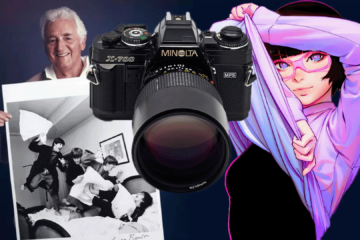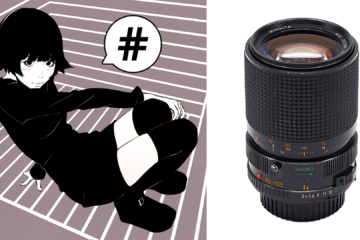Minolta MD 70-210mm 1:4.0 Zoom – review

Minolta MD 70-210mm 1:4.0 Zoom lens review
- Official classification: New-MD
- Collector’s classification: MD III
This is a manual-focus version of “Beercan” – one of the famous lenses of Minolta. A rare case when the description is worth starting with the mention of another younger lens because everyone knows a “Beercan.” It’s enough to say that this is “beercan without autofocus” and everyone immediately understands what it is about. It is believed that the optical properties of the lens weren’t changed when autofocus appeared, but a small probability still remains, therefore I’ll clarify – the review is about MD, not about Alpha.
Tests for this review are divided for 70mm, 100mm, 150mm, 210mm groups.
Minolta MD 70-210mm 1:4.0 Zoom specifications
| # in minolta.eazypix.de index | 269 |
| Name engraved on lens | MD ZOOM |
| f[mm] | 70-210 |
| A max [1/f] | 4 |
| A min[1/f] | 32 |
| Lens design [el.] | 12 |
| Lens design [gr.] | 9 |
| Filter thread Ø front(rear)[mm] | 55 |
| Lens Shade | clip-in |
| closefocus[m/ft] | 1.1/4 |
| Dimension Ø x length [mm] | 72×153 |
| Weight[g] | 635 |
| Year | 1983 |
| Style | MD III |
| Code No. (ROKKOR-X) or Order No. | 2514-110 |
| Notes | 1-Touch |
More data
| Floating elements | NO |
| Aperture blades number | 6 |
| Confidence in the test results of reviewed copies | High |
| Reviewed Lens SN: | 1099456 |
Minolta MD 70-210mm 1:4.0 Zoom lens exterior
Lens shade (lens hood)
Minolta MD 70-210mm 1:4.0 Zoom mounted on Minolta X-700
Minolta MD 70-210mm 1:4.0 Zoom sharpness
Сlose-distance resolution test, minimal distance
Testing methods description
- Target: 10-15 cm picture, printed on glossy photo paper
- Distance: 1.7m
- Camera: Sony A7II (24mpx, full-frame, tripod, remote control). M-mode, ISO fixed, WB fixed, SteadyShot – OFF.
- The test was repeated for every F-stop on every focus position with manual focus adjustment for each shot. That is to avoid the effect of field curvature.
- RAW processing: Capture One, default settings. All quality settings – 100%. Crops – 300×200 px
Original target image (printed in horizontal orientation on 10cm X 15cm glossy photo paper
Long-distance resolution test
Testing methods description
- Target: cityscape
- Distance: > 200 meters to center focus point
- Camera: Sony A7II (24mpx, full-frame, tripod, remote control). M-mode, ISO fixed, WB fixed, SteadyShot – OFF. The focus point is on the center only.
- RAW processing: Capture One, default settings. All quality settings – 100%. Crops – 300×200 px
Minolta MD 70-210mm 1:4.0 Zoom TEST RESULTS on FOCUS DISTANCE = 70mm
70mm – Sharpness – short distance
70mm – Scene preview:
70mm – Test results
70mm – Sharpness – long distance
70mm – Scene preview
70mm – Test results
70mm – Vignetting
70mm – Geometric distortion
70mm – Coma aberrations
70mm – Chromatic aberrations
70mm – Long-distance bokeh
Test conditions: lens was focused on minimal distance 1.2m, houses were fixed in infinity distance on the ground.
70mm – Light bubbles long-distance bokeh
Test conditions: lens was focused on minimal distance 1.2m, lights were fixed in more than 200m
Test #2
Test conditions: lens was focused on 2.0m, houses were fixed in infinity distance on the ground
Minolta MD 70-210mm 1:4.0 Zoom TEST RESULTS on FOCUS DISTANCE = 100mm
100mm – Sharpness – a short distance
100mm – Scene preview
100mm – Test results
100mm – Sharpness – long distance
100mm – Scene preview
100mm – Test results
100mm – Vignetting
100mm – Geometric distortion
100mm – Coma aberrations
100mm – Chromatic aberrations
100mm – Long-distance bokeh:
Test conditions: lens was focused on minimal distance 1.2m, houses were fixed in infinity distance on the ground.
100mm – Light bubbles long-distance bokeh
Test #1
Test conditions: lens was focused on minimal distance 1.2m, lights were fixed in more than 200m.
Test #2
Test conditions: lens was focused on 2.0m, houses were fixed in infinity distance on the ground.
Minolta MD 70-210mm 1:4.0 Zoom TEST RESULTS on FOCUS DISTANCE = 150mm
150mm – Sharpness – a short distance
150mm – Scene preview
150mm – Test results
150mm – Sharpness – long distance
150mm – Scene preview
150mm – Test results
150mm – Vignetting
150mm – Geometric distortion
150mm – Coma aberrations
150mm – Chromatic aberrations
150mm – Long-distance bokeh
Test conditions: lens was focused on minimal distance 1.2m, houses were fixed in infinity distance on the ground.
150mm – Light bubbles long-distance bokeh:
Test #1
Test conditions: lens was focused on minimal distance 1.2m, lights were fixed in more than 200m
Test #2
Test conditions: lens was focused on 2.0m, houses were fixed in infinity distance on the ground
Minolta MD 70-210mm 1:4.0 Zoom TEST RESULTS on FOCUS DISTANCE = 210mm
210mm – Sharpness – a short distance
210mm – Scene preview
210mm – Test results
210mm – Sharpness – long distance
210mm – Scene preview
210mm – Test results
210mm – Vignetting
210mm – Geometric distortion
210mm – Coma aberrations
210mm – Chromatic aberrations
210mm – Long-distance bokeh
Test#1:
Test conditions: lens was focused on minimal distance 1.2m, houses were fixed in infinity distance on the ground
210mm – Light bubbles long-distance bokeh:
Test #1
Test conditions: lens was focused on minimal distance 1.2m, lights were fixed in more than 200m
Test #2
Test conditions: lens was focused on 2.0m, houses were fixed in infinity distance on the ground
Minolta MD 70-210mm 1:4.0 Zoom – final conclusion
Before testing, I was afraid that the lens would not be as good as it might be expected – yes, it is very famous but it is still a zoom lens. Hopefully, it turned out that my imagination about its IQ was a little lower than reality, it’s a good sign.
Let’s start with the disadvantages
Firstly, the chromatic aberrations. It’s the biggest weak side of this lens, to be honest – it isn’t a big problem for digital cameras, but it means that editing is required. Secondly, geometric aberrations can be spotted on almost any focal distance. This is typical behavior for zooms, so, again – nothing serious, just keep it in mind. Thirdly, my personal regret is the 1-touch ring – zooming and focusing mixed in the one ring. I admit that if the owner gets used to this design, then it may be convenient.
As for size and weight, the lens is rather big. But it seems that creating a lens with a similar IQ, constant aperture at all focal lengths, and for a full-frame is hardly possible. One of these three properties will have to be sacrificed. So – it is not a disadvantage, just physics.
Advantages
Here is the only one, but a very big point: overall/mixed IQ is great. This zoom isn’t a “primes-killer” but the idea to take this one instead of a pack “85 – 135 – 200” or something like this looks very good. Especially if the target is portraiture – I was impressed mostly by the sharpness distribution over the frame on any aperture than by total resolutions.
Of course, the lens has an amazing bokeh, on any apertures. Probably, it happens because any back- or front- ground with F4-5.6 on so long distances will be detached from an object with a large margin – enough for any portraits, but again – it’s because of physics, not because of the lens.
As a result
This MD 70-210 is not an ultra-sharp, not ultra-fast, with not ideal geometry and with a set of aberrations. But all these weaknesses are small, so no one of these reasons can displace this lens from the pedestal. This is one of the lenses with the most balanced IQ I have ever seen. If this 1-touch design suits you, then I recommend the lens.





































































9 Comments
Muenchi · 2020-06-06 at 09:02
The MD 75-150 is so much better.
Had both – sold the 70-210 quickly because I was spoilt by the 75-150.
75-150 is much sharper and has nearly NO chromatic aberrations. Plus, very compact and light.
bernhard1965 · 2020-08-09 at 16:53
Thank you for your test blog. I like old vintage lenses too. So i will follow now u blog.
Best regards
Bernhard
https://deramateurphotograph.de
Bruce · 2020-11-13 at 05:10
I have one in near mint condition. I bought it new after my Dad had bought a cheaper zoom. I’m going to try it on my Nikon D850. I’ll let you know…
Maciek · 2020-12-21 at 16:32
Did You have contact with MD 75-200mm 1:4.5? I was looking for some informations, but opinions about this heavy-glass are strongly divided.
Tony · 2020-12-21 at 16:41
I’ve got one in nice condition for review but need to wait for the spring. Sorry, it will take three months or so
Howie Dewing · 2021-06-03 at 04:22
I’m back again, Tony, and, yes, I have this lens also. This one tests my nearly fifty-nine year old nerves on my 35mm Minoltas, so I practice using it on my a7 II with the Steady Shot turned off to see how steady I can hold it. With the lens shade on, it looks like a battleship’s gun barrel, but I have an AF APO Minolta 80-200mm f/2.8 monster you could fit this lens inside of with plenty of room to spare. The one-touch focus/zoom ring definitely takes some getting used to, but the waffle grip is so immense it’s impossible to not find. Mine is in nearly new shape, but it has “lens creep” like a slinky. Overall, my “Beercan’s” daddy is still alive and doing very well.
Tony · 2021-06-04 at 16:41
Hello,
Yes, yes! This lens is really good, it was transplanted to an autofocused A-mount without changing the optical formula – and become the legend in that reincarnation. But I still think that ‘2-rings’ zooms are more convenient than ‘1-ring’. Maybe I’m just not used to it yet ))
Bushcrafter · 2024-01-21 at 12:33
Hello, great reviews here!
Small note: the results for the 210mm position have disappeared – photos cannot be consulted.
Keep up the good work!
Marc.
Tony · 2024-01-21 at 13:56
Hello Bushcrafter! Thank you as lot, I fixed these missed pictures (sometimes or better to say rare it happens with random pics, I don’t know why)